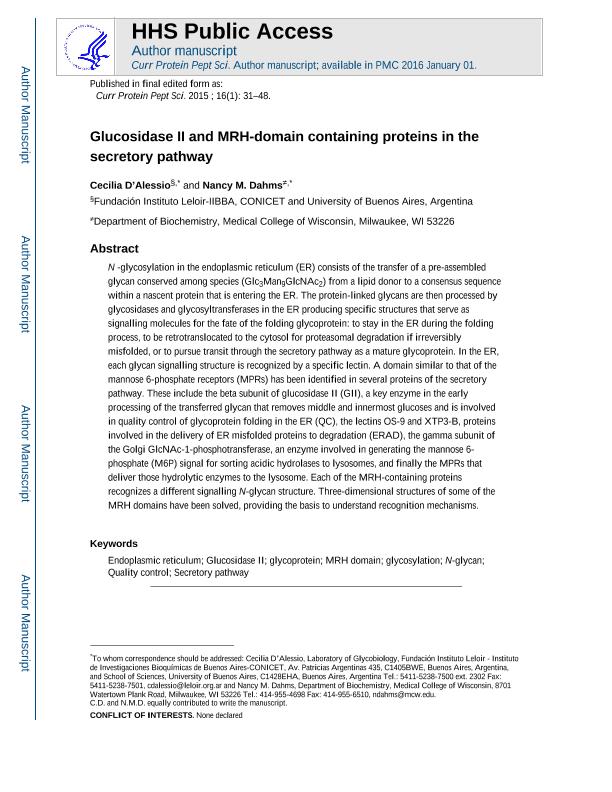Mostrar el registro sencillo del ítem
dc.contributor.author
D'alessio, Cecilia

dc.contributor.author
Dahms, Nancy M.
dc.date.available
2016-11-24T14:40:19Z
dc.date.issued
2015-01
dc.identifier.citation
D'alessio, Cecilia; Dahms, Nancy M.; Glucosidase II and MRH-Domain Containing Proteins in the Secretory Pathway; Bentham Science Publishers; Current Protein and Peptide Science; 16; 1; 1-2015; 31-48
dc.identifier.issn
1389-2037
dc.identifier.uri
http://hdl.handle.net/11336/8338
dc.description.abstract
N-glycosylation in the endoplasmic reticulum (ER) consists of the transfer of a preassembled glycan conserved among species (Glc3Man9GlcNAc2) from a lipid donor to a consensus sequence within a nascent protein that is entering the ER. The protein-linked glycans are then processed by glycosidases and glycosyltransferases in the ER producing specific structures that serve as signalling molecules for the fate of the folding glycoprotein: to stay in the ER during the folding process, to be retrotranslocated to the cytosol for proteasomal degradation if irreversibly misfolded, or to pursue transit through the secretory pathway as a mature glycoprotein. In the ER, each glycan signalling structure is recognized by a specific lectin. A domain similar to that of the mannose 6-phosphate receptors (MPRs) has been identified in several proteins of the secretory pathway. These include the beta subunit of glucosidase II (GII), a key enzyme in the early processing of the transferred glycan that removes middle and innermost glucoses and is involved in quality control of glycoprotein folding in the ER (QC), the lectins OS-9 and XTP3-B, proteins involved in the delivery of ER misfolded proteins to degradation (ERAD), the gamma subunit of the Golgi GlcNAc-1-phosphotransferase, an enzyme involved in generating the mannose 6-phosphate (M6P) signal for sorting acidic hydrolases to lysosomes, and finally the MPRs that deliver those hydrolytic enzymes to the lysosome. Each of the MRH-containing proteins recognizes a different signalling N-glycan structure. Three-dimensional structures of some of the MRH domains have been solved, providing the basis to understand recognition mechanisms.
dc.format
application/pdf
dc.language.iso
eng
dc.publisher
Bentham Science Publishers

dc.rights
info:eu-repo/semantics/openAccess
dc.rights.uri
https://creativecommons.org/licenses/by-nc-sa/2.5/ar/
dc.subject
Glucosidase Ii
dc.subject
Secretory Pathway
dc.subject
Mrh Domain
dc.subject
Glycoprotein
dc.subject.classification
Bioquímica y Biología Molecular

dc.subject.classification
Ciencias Biológicas

dc.subject.classification
CIENCIAS NATURALES Y EXACTAS

dc.title
Glucosidase II and MRH-Domain Containing Proteins in the Secretory Pathway
dc.type
info:eu-repo/semantics/article
dc.type
info:ar-repo/semantics/artículo
dc.type
info:eu-repo/semantics/publishedVersion
dc.date.updated
2016-11-18T15:20:38Z
dc.journal.volume
16
dc.journal.number
1
dc.journal.pagination
31-48
dc.journal.pais
Estados Unidos

dc.journal.ciudad
Oak Park
dc.description.fil
Fil: D'alessio, Cecilia. Consejo Nacional de Investigaciones Científicas y Técnicas. Oficina de Coordinación Administrativa Parque Centenario. Instituto de Investigaciones Bioquimicas de Buenos Aires; Argentina. Universidad de Buenos Aires; Argentina
dc.description.fil
Fil: Dahms, Nancy M.. Department of Biochemistry. Medical College of Wisconsin; Estados Unidos
dc.journal.title
Current Protein and Peptide Science

dc.relation.alternativeid
info:eu-repo/semantics/altIdentifier/url/http://benthamscience.com/journals/current-protein-and-peptide-science/volume/16/issue/1/page/31/
dc.relation.alternativeid
info:eu-repo/semantics/altIdentifier/doi/http://dx.doi.org/10.2174/1389203716666150213160438
dc.relation.alternativeid
info:eu-repo/semantics/altIdentifier/url/https://www.ncbi.nlm.nih.gov/pmc/articles/PMC4411176/
Archivos asociados
